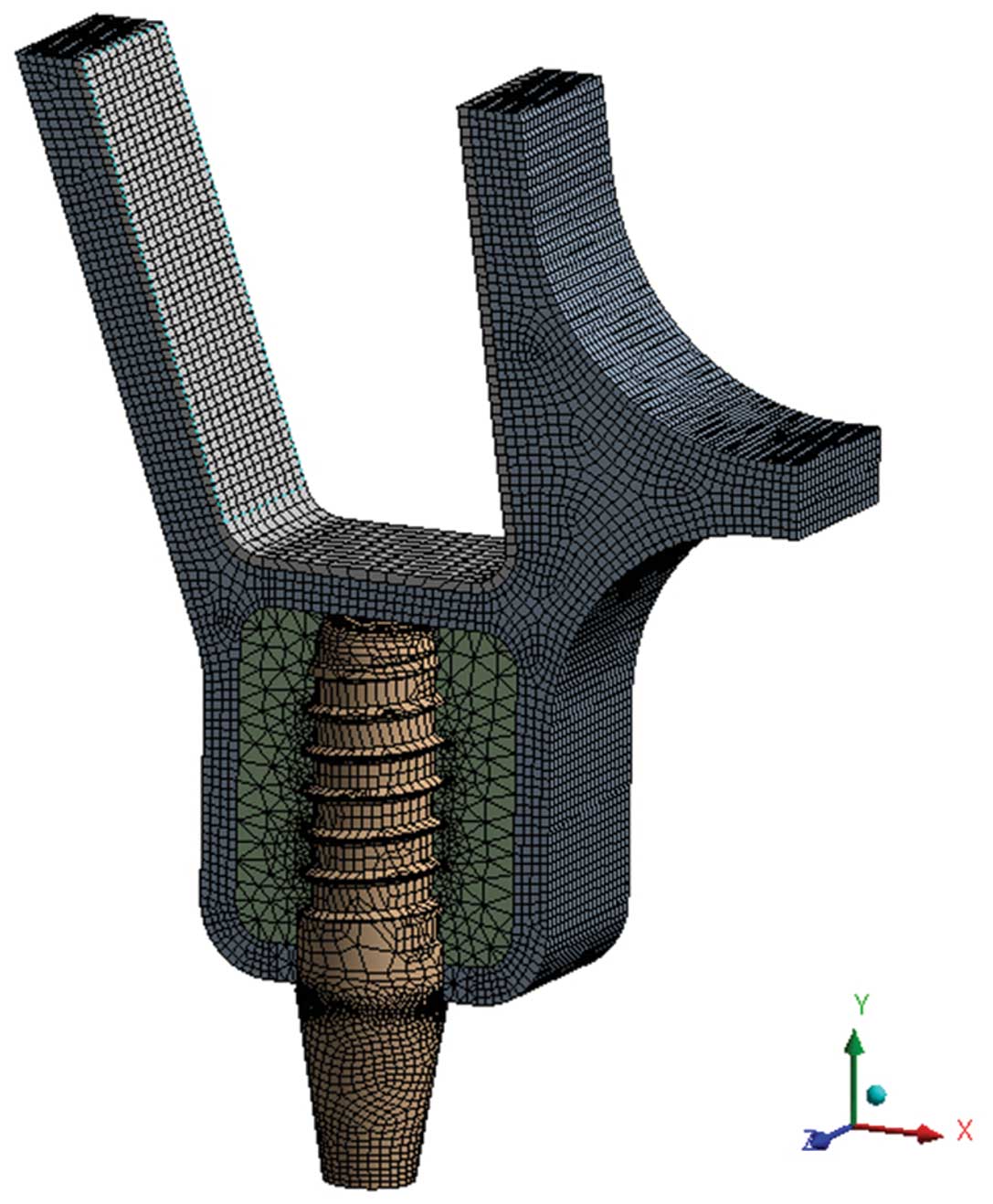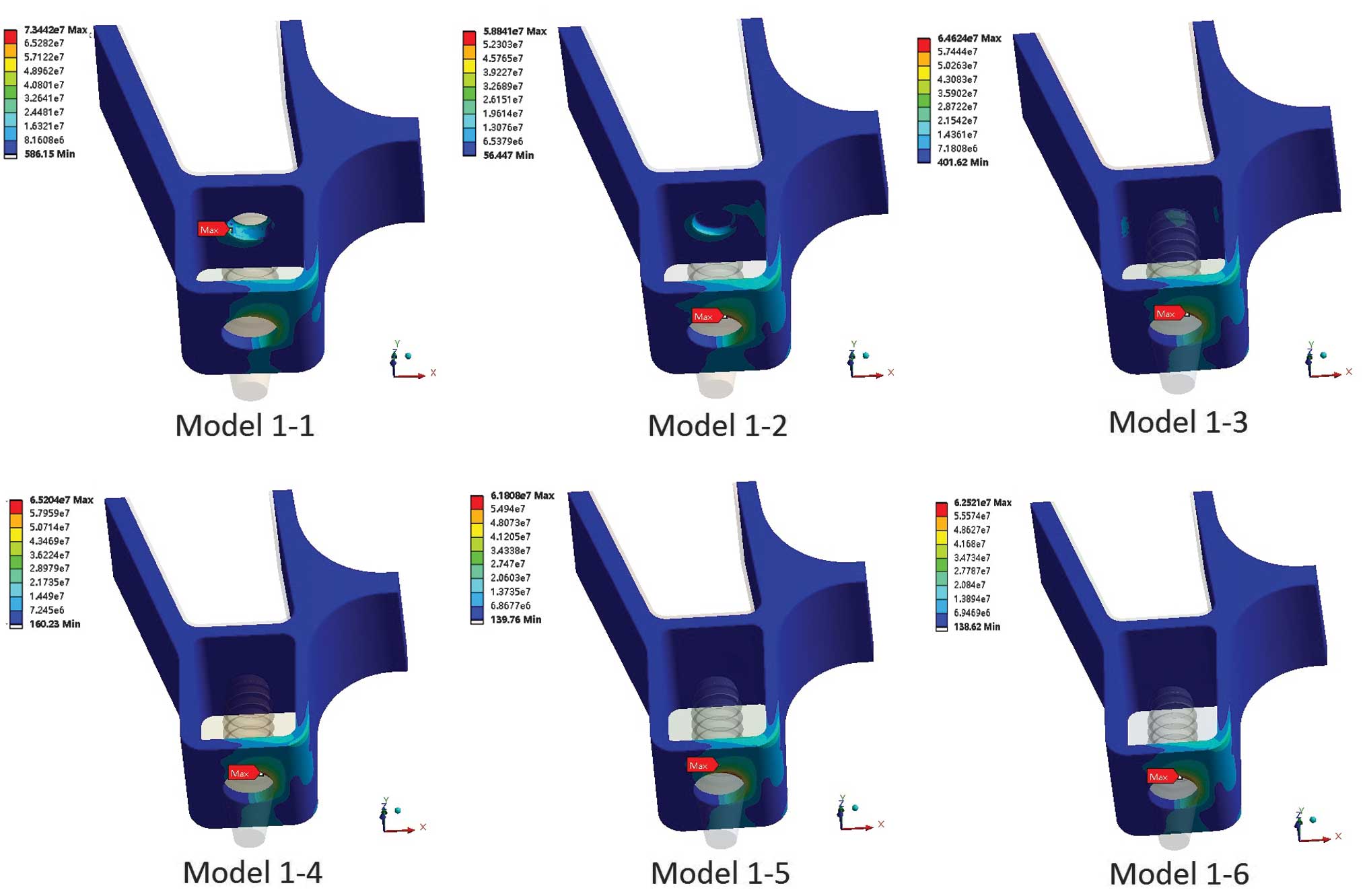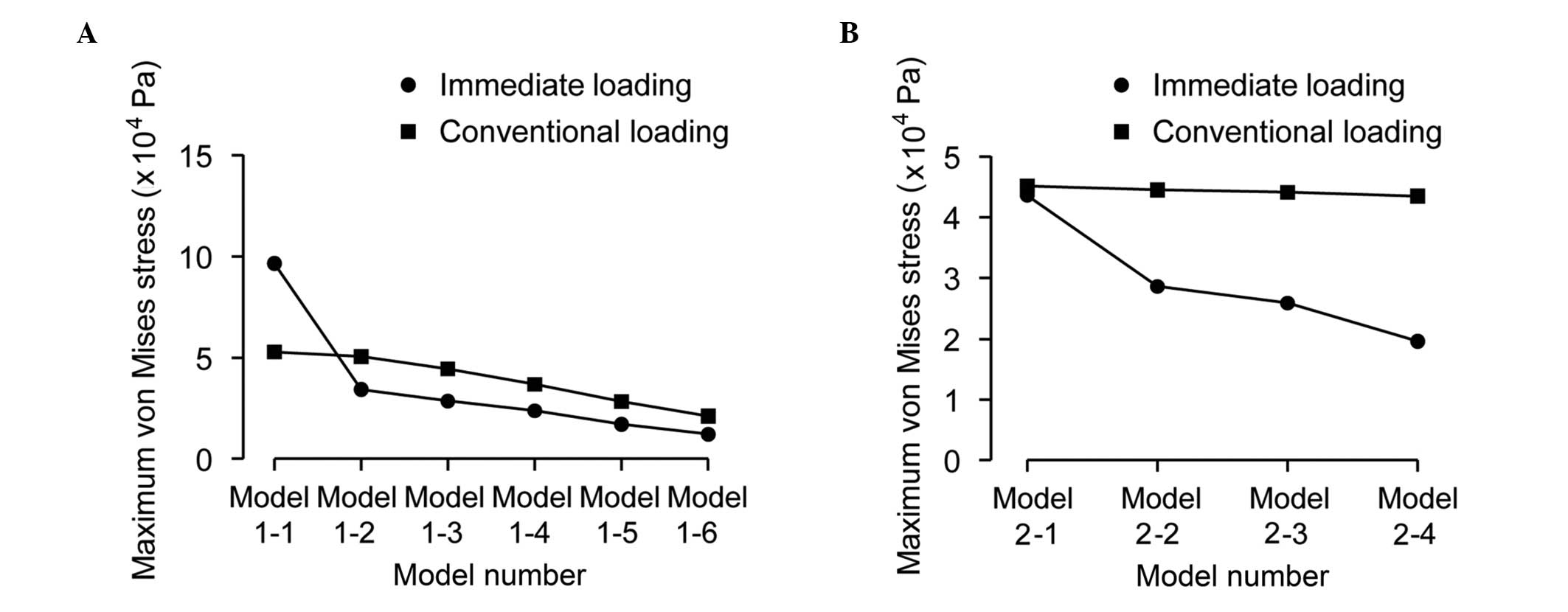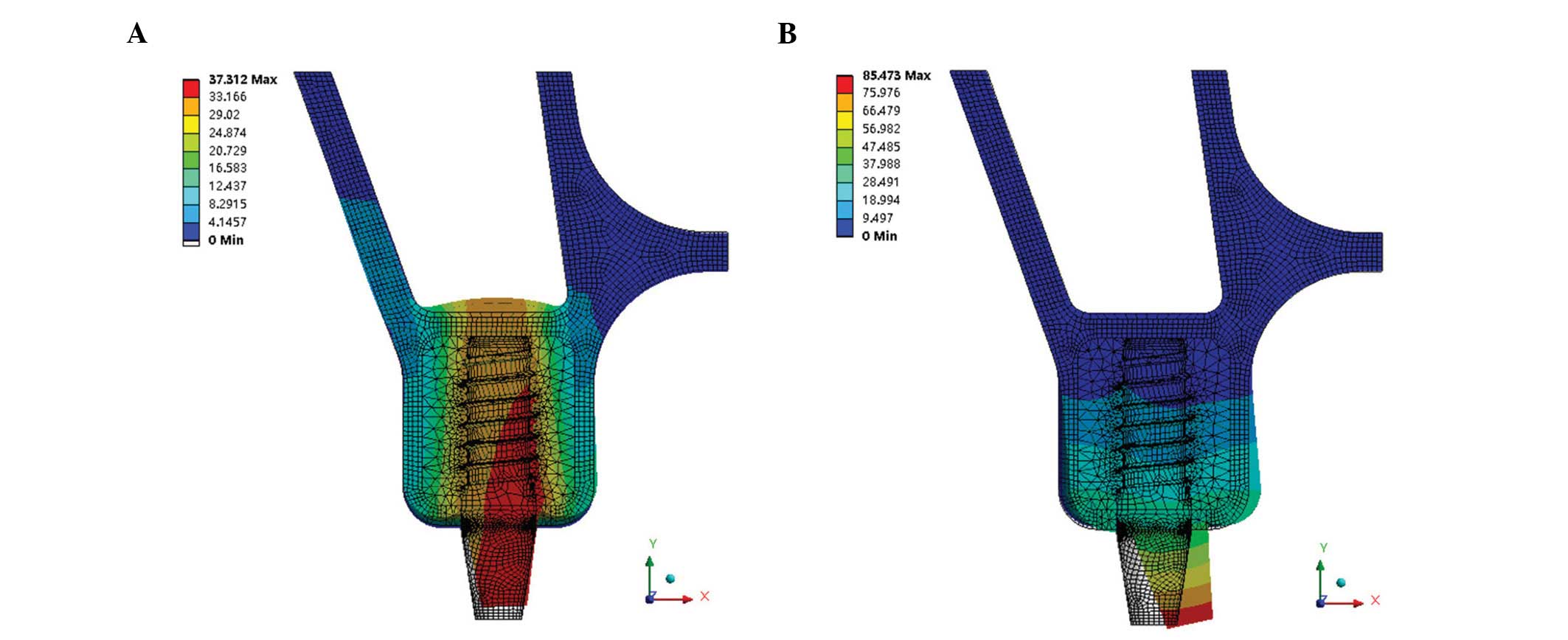|
1
|
Winter W, Krafft T, Steinmann P and Karl
M: Quality of alveolar bone - structure-dependent material
properties and design of a novel measurement technique. J Mech
Behav Biomed Mater. 4:541–548. 2011. View Article : Google Scholar : PubMed/NCBI
|
|
2
|
Ding X, Zhu XH, Liao SH, Zhang XH and Chen
H: Implant-bone interface stress distribution in immediately loaded
implants of different diameters: a three-dimensional finite element
analysis. J Prosthodont. 18:393–402. 2009. View Article : Google Scholar : PubMed/NCBI
|
|
3
|
Meredith N, Books K, Friberg B, Jemt T and
Sennerby L: Resonance frequency measurements of implant stability
in vivo. A cross-sectional and longitudinal study of resonance
frequency measurements on implants in the edentulous and partially
dentate maxilla. Clin Oral Implants Res. 8:226–233. 1997.
View Article : Google Scholar : PubMed/NCBI
|
|
4
|
Mohammed Ibrahim M, Thulasingam C, Nasser
KS, Balaji V, Rajakumar M and Rupkumar P: Evaluation of design
parameters of dental implant shape, diameter and length on stress
distribution: a finite element analysis. J Indian Prosthodont Soc.
11:165–171. 2011. View Article : Google Scholar :
|
|
5
|
Lee JH, Frias V, Lee KW and Wright RF:
Effect of implant size and shape on implant success rates: a
literature review. J Prosthet Dent. 94:377–381. 2005. View Article : Google Scholar : PubMed/NCBI
|
|
6
|
Toniollo MB, Macedo AP, Rodrigues RC,
Ribeiro RF and de Mattos Mda G: Three-dimensional finite element
analysis of stress distribution on different bony ridges with
different lengths of morse taper implants and prosthesis
dimensions. J Craniofac Surg. 23:1888–1892. 2012. View Article : Google Scholar : PubMed/NCBI
|
|
7
|
Jeong CM, Caputo AA, Wylie RS, Son SC and
Jeon YC: Bicortically stabilized implant load transfer. Int J Oral
Maxillofac Implants. 18:59–65. 2003.PubMed/NCBI
|
|
8
|
Geng JP, Tan KB and Liu GR: Application of
finite element analysis in implant dentistry: a review of the
literature. J Prosthet Dent. 85:585–598. 2001. View Article : Google Scholar : PubMed/NCBI
|
|
9
|
Van Staden RC, Guan H and Loo YC:
Application of the finite element method in dental implant
research. Comput Methods Biomech Biomed Engin. 9:257–270. 2006.
View Article : Google Scholar : PubMed/NCBI
|
|
10
|
Bozkaya D, Muftu S and Muftu A: Evaluation
of load transfer characteristics of five different implants in
compact bone at different load levels by finite elements analysis.
J Prosthet Dent. 92:523–530. 2004. View Article : Google Scholar : PubMed/NCBI
|
|
11
|
Chang PC, Lang NP and Giannobile WV:
Evaluation of functional dynamics during osseointegration and
regeneration associated with oral implants. Clin Oral Implants Res.
21:1–12. 2010. View Article : Google Scholar : PubMed/NCBI
|
|
12
|
Huang HM, Lee SY, Yeh CY and Lin CT:
Resonance frequency assessment of dental implant stability with
various bone qualities: a numerical approach. Clin Oral Implants
Res. 13:65–74. 2002. View Article : Google Scholar : PubMed/NCBI
|
|
13
|
Pattijn V, Van Lierde C, Van der Perre G,
Naert I and Vander Sloten J: The resonance frequencies and mode
shapes of dental implants: Rigid body behaviour versus bending
behaviour. A numerical approach. J Biomech. 39:939–947. 2006.
View Article : Google Scholar : PubMed/NCBI
|
|
14
|
Pommer B, Unger E, Sütö D, Hack N and
Watzek G: Mechanical properties of the Schneiderian membrane in
vitro. Clin Oral Implants Res. 20:633–637. 2009.PubMed/NCBI
|
|
15
|
Underwood AS: An inquiry into the anatomy
and pathology of the maxillary sinus. J Anat Physiol. 44:354–369.
1910.PubMed/NCBI
|
|
16
|
Ulm CW, Solar P, Gsellmann B, Matejka M
and Watzek G: The edentulous maxillary alveolar process in the
region of the maxillary sinus - a study of physical dimension. Int
J Oral Maxillofac Surg. 24:279–282. 1995. View Article : Google Scholar : PubMed/NCBI
|
|
17
|
van den Bergh JP, ten Bruggenkate CM,
Disch FJ and Tuinzing DB: Anatomical aspects of sinus floor
elevations. Clin Oral Implants Res. 11:256–265. 2000. View Article : Google Scholar
|
|
18
|
Gosau M, Rink D, Driemel O and Draenert
FG: Maxillary sinus anatomy: a cadaveric study with clinical
implications. Anat Rec (Hoboken). 292:352–354. 2009. View Article : Google Scholar
|
|
19
|
Rues S, Lenz J, Schierle HP, Schindler HJ
and Schweizerhof K: Simulation of the sinus floor elevation. Proc
Appl Math Mech. 4:368–369. 2004. View Article : Google Scholar
|
|
20
|
Huang CC, Chen LW, Wu DF and Chen YC:
Finite element simulations of the contact stress between rotary
sinus lift kit and sinus membrane during lifting process. Life Sci
J. 9:167–171. 2012.
|
|
21
|
Mellal A, Wiskott HW, Botsis J, Scherrer
SS and Belser UC: Stimulating effect of implant loading on
surrounding bone. Comparison of three numerical models and
validation by in vivo data. Clin Oral Implants Res. 15:239–248.
2004. View Article : Google Scholar : PubMed/NCBI
|
|
22
|
Morneburg TR and Pröschel PA: Measurement
of masticatory forces and implant loads: a methodologic clinical
study. Int J Prosthodont. 15:20–27. 2002.PubMed/NCBI
|
|
23
|
Lekholm U, Zarb GA and Albrektsson T:
Tissue Integrated Prostheses: Osseointegration in Clinical
Dentistry. Quintessence Publishing; Chicago, IL, USA: pp. 199–209.
1985
|
|
24
|
Okumura N, Stegaroiu R, Nishiyama H,
Kurokawa K, Kitamura E, Hayashi T and Nomura S: Finite element
analysis of implant-embedded maxilla model from CT data: comparison
with the conventional model. J Prosthodont Res. 55:24–31. 2011.
View Article : Google Scholar
|
|
25
|
Akca K and Cehreli MC: Biomechanical
consequences of progressive marginal bone loss around oral
implants: a finite element stress analysis. Med Biol Eng Comput.
44:527–535. 2006. View Article : Google Scholar : PubMed/NCBI
|
|
26
|
Cannizzaro G, Felice P, et al: Early
implant loading in the atrophic posterior maxilla: 1-stage lateral
versus crestal sinus lift and 8 mm hydroxyapatite-coated implants.
A 5-year randomised controlled trial. Eur J Oral Implant. 6:13–25.
2013.
|
|
27
|
Doan N, Du Z, Crawford R, Reher P and Xiao
Y: Is flapless implant surgery a viable option in posterior
maxilla? A review. Int J Oral Maxillofac Surg. 41:1064–1071. 2012.
View Article : Google Scholar : PubMed/NCBI
|
|
28
|
Wang D, Künzel A, Golubovic V, et al:
Accuracy of peri-implant bone thickness and validity of assessing
bone augmentation material using cone beam computed tomography.
Clin Oral Investig. 17:1601–1609. 2013. View Article : Google Scholar
|
|
29
|
Chou IC, Lee SY, Wu MC, Sun CW and Jiang
CP: Finite element modelling of implant designs and cortical bone
thickness on stress distribution in maxillary type IV bone. Comput
Methods Biomech Biomed Engin. 17:516–526. 2014. View Article : Google Scholar
|
|
30
|
Sul SH, Choi BH, Li J, Jeong SM and Xuan
F: Histologic changes in the maxillary sinus membrane after sinus
membrane elevation and the simultaneous insertion of dental
implants without the use of grafting materials. Oral Surg Oral Med
Oral Pathol Oral Radiol Endod. 105:e1–e5. 2008. View Article : Google Scholar : PubMed/NCBI
|
|
31
|
Pjetursson BE, Rast C, Brägger U,
Schmidlin K, Zwahlen M and Lang NP: Maxillary sinus floor elevation
using the (transalveolar) osteotome technique with or without
grafting material. Part I: Implant survival and patients’
perception. Clin Oral Implants Res. 20:667–676. 2009. View Article : Google Scholar : PubMed/NCBI
|




















